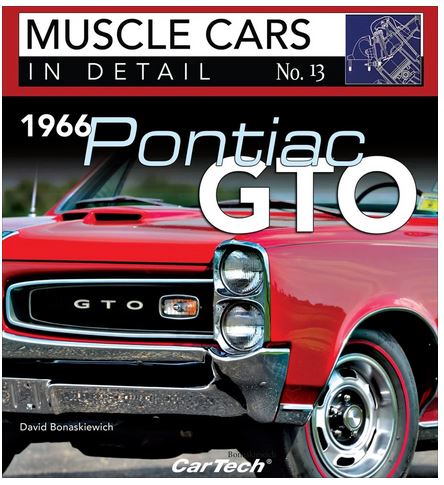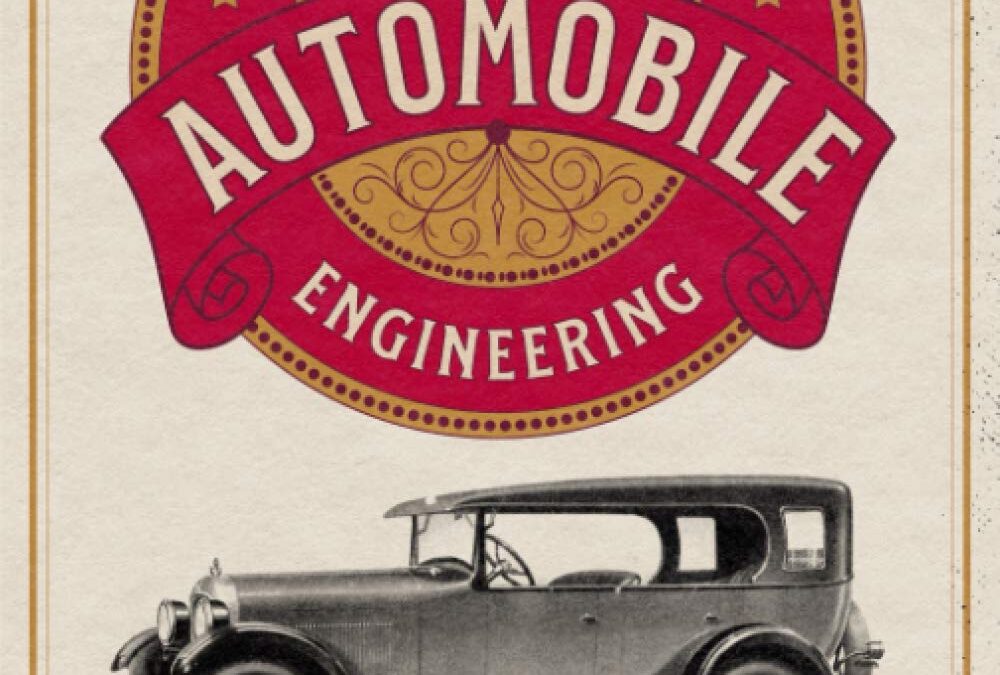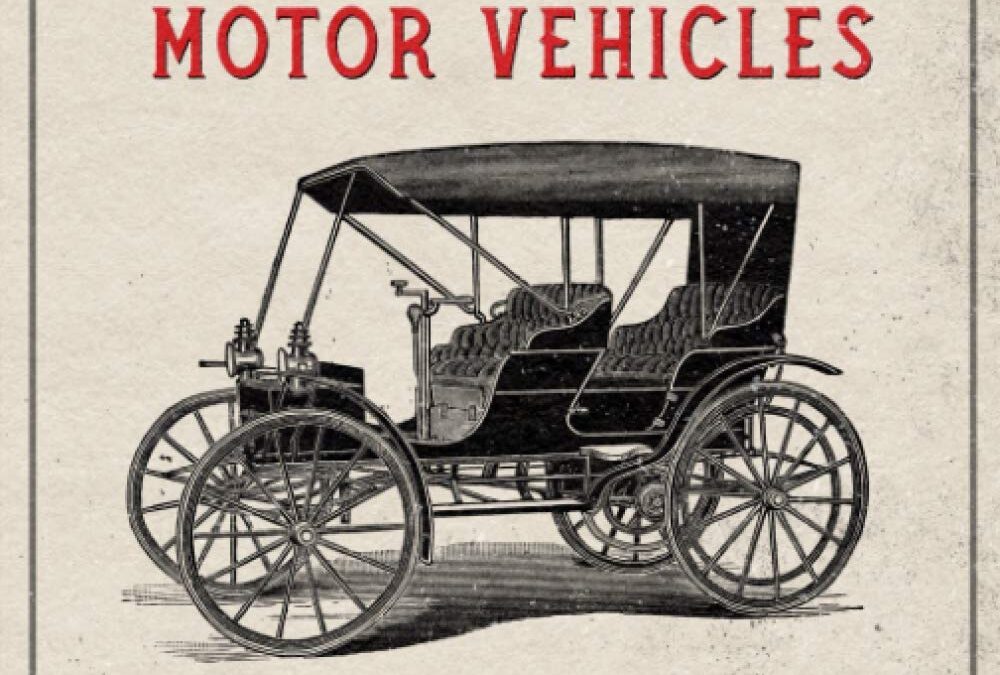
Art Evans’ relationship to Bill Devin is unique. From the time of the fifties, they were close friends as well as business associates. When Bill passed on in November 2000, Bill’s widow asked Art to deliver the eulogy at the service. Bill Devin created a number of cars as well as the best-selling after-market fiberglass body. Bill’s first car was the Devin Panhard, a limited-edition sports-racing car that won its class in the SCCA National Championship. In 1958, he created the fabled Devin SS, which was soon followed by the Devin D and the Devin C, an all-American sports car. All of these cars are described in great detail in this book. Some of the Devin after-market bodies were used on quite a few racing specials including Ack Miller’s, that won its class six times in eight tries. Not just a car book, Devin’s history is described in some detail as well as a few of those with whom he was associated.

The Bizarre and Disturbing Adventures of Hitler’s Limousine in America
In 1938, Mercedes-Benz began production of the largest, most luxurious limousine in the world. A machine of frightening power and sinister beauty, the Grosser 770K Model 150 Offener Tourenwagen was 20 feet long, seven feet wide, and tipped the scales at 5 tons. Its supercharged, 230-horsepower engine propelled the beast to speeds over 100 m.p.h. while its occupants reclined on glove-leather seats stuffed with goose down. Armor plated and equipped with hidden compartments for Luger pistols, the 770K was a sumptuous monster with a monstrous patron: Adolph Hitler and the Nazi party.
Deployed mainly for propaganda purposes before the war, the hand-built limousines―in which Hitler rode standing in the front seat―motored through elaborate rallies and appeared in countless newsreels, swiftly becoming the Nazi party’s most durable symbol of wealth and power. Had Hitler not so thoroughly dominated the scene with his own megalomania, his opulent limousine could easily have eclipsed him.
Most of the 770Ks didn’t make it out of the rubble of World War II. But several of them did. And two of them found their way, secretly and separately, to the United States.
In The Devil’s Mercedes, author Robert Klara uncovers the forgotten story of how Americans responded to these rolling relics of fascism on their soil. The limousines made headlines, drew crowds, made fortunes and ruined lives. What never became public was how both of the cars would ultimately become tangled in a web of confusion, mania, and opportunism, fully entwined in a story of mistaken identity.
Nobody knew that the limousine touted as Hitler’s had in fact never belonged to him, while the Mercedes shrugged off as an ordinary staff car―one later abandoned in a warehouse and sold off as government surplus―turned out to be none other than Hitler’s personal automobile.
It would take 40 years, a cast of carnies and millionaires, the United States Army, and the sleuthing efforts of an obscure Canadian librarian to bring the entire truth to light.
As he recounts this remarkable drama, Klara probes the meaning of these haunting hulks and their power to attract, excite and disgust. The limousines’ appearance collided with an American populous celebrating a victory even as it sought to stay a step ahead of the war’s ghosts. Ultimately, The Devil’s Mercedes isn’t only the story of a rare and notorious car, but what that car taught postwar America about itself.
Keith S. Herbst

“Today’s NASCAR is a family sport with 75 million loyal fans, growing bigger and more mainstream by the day. Part Disney, part Vegas, part Barnum& Bailey, NASCAR is also a multi-billion dollar business and a cultural phenomenon that transcends geography, class, and gender. But dark secrets lurk in NASCAR’s past.
Driving with the Devil uncovers for the first time the true story behind NASCAR’s distant, moonshine-fueled origins and paints a rich portrait of the colorful men who created it. Long before the sport of stock-car racing even existed, young men in the rural, Depression-wracked South had figured out that cars and speed were tickets to a better life. With few options beyond the farm or factory, the best chance of escape was running moonshine. Bootlegging offered speed, adventure and wads of cash – if they survived. Driving with the Devil is the story of bootleggers whose empires grew during Prohibition and continued to thrive well after Repeal, and of drivers who thundered down dusty back roads with a car full of corn liquor, deftly out-running federal revenuers. The vehicle of choice was the Ford V-8, the hottest car of the 1930s, and ace mechanics tinkered with them until they could fly across mountain roads at 100 miles an hour.
After fighting in World War II, moonshiners transferred their skills to the rough, red-dirt race tracks of Dixie, and a national sport was born. In this dynamic era (1930s and 40s), three men with a passion for Ford V-8s – convicted felon Raymond Parks, foul-mouthed mechanic Red Vogt, and crippled war vet Red Byron, NASCAR’s first champion – emerged as the first stock car “”team.”” Theirs is the violent, poignant story of how moonshine and fast cars merged to create a new sport for the South to call its own.
Driving with the Devil is a fascinating look at the well-hidden historical connection between whiskey running and stock-car racing. NASCAR histories will tell you who led every lap of every race since the first official race was held in 1948. Driving with the Devil goes deeper to bring you the excitement, passions, crime, and death-defying feats of the wild, early days that NASCAR has carefully hidden from public view. In the tradition of Laura Hillenbrand’s Seabiscuit, this tale not only reveals a by-gone era of a beloved sport, but also the character of the country at a moment in time.”
Caddy DEVILLE/SEVILLE 92-05
Devils and Angels
The Devil at Your Feet
The Devil Can RIde
Devil at My Heels
Eugene Ely, Daredevil Aviator

Pontiac’s GTO is often credited as being the first muscle car. As model year 1966 ended, an astounding 96,946 GTOs traversed Pontiac assembly lines, which set a high-water mark that would cement the GOAT as the most salable muscle car that was produced during the golden age of performance.
Author David Bonaskiewich examines this model year in precise detail, taking into account every cosmetic change and optional hardware that warranted this sales boom. The Coke-bottle styling for the remodeled GTO certainly tipped the scales for some consumers. However, as they say, “The devil is in the details.”
This book delves into those details, showcasing the vast array of optional equipment across its three bodystyles (hardtop, sports coupe, and convertible). Thorough examinations of the drivetrain, interior, suspension, brakes, and wheels and tires are exhaustive, which unveils exactly why the 1966 GTO was the most successful muscle car ever assembled.
Tune up those Tri-Power carburetors, turn on your favorite tune, and twist the key with 1966 Pontiac GTO: In Detail!

This book is unique. It not only tells you how carburetors work – but more importantly – why.
Carburetors, like many parts of a car, are not stand-alone devices. A carburetor’s “success” is highly dependent on many related components working together, just like the members of a football team must work together in order to win. We will discuss all aspects of the fuel and air systems of a gasoline engine from the gas tank until the air-fuel mixture enters the combustion chamber. To be able to effectively understand, diagnose and repair carburetors, it is important to understand all of these inter-related systems.
This book will complement the various service manuals you have for your cars. Some books have very good, detailed carburetor descriptions, while others are limited in the discussion of how the particular carburetor works. This book is not intended to replace these manuals, but to give you fundamental knowledge that will apply to virtually all carburetor designs. This book also includes more than just carburetor information, since it is the complete fuel, air, ignition and intake manifold systems that are important to fully understand your vehicle.
Over the past several years, I have been studying the Marvel carburetor calibrations on early Buicks and reporting the results in my “Early Buick and McLaughlin-Buick Owners” newsletter. The variation in air–fuel ratio (A/F) I observed on my 1916 and 1929 Buicks led me to do a more detailed analysis of intake manifold designs, which are critical to achieving an optimum carburetor calibration. It is interesting to see how both intake manifold designs and fuel delivery techniques evolved over the last 100 years.
In addition to my own antique cars, I have been involved in some interesting restorations of historically significant General Motor vehicles. I restored three carburetors used on the restoration of the GM Futurliner #10 and rebuilt the four side-draft carburetors used on the 1956X Buick concept car both restored by my good friend Don Mayton in Michigan. While both vehicles used standard production carburetors, the unique applications made them an interesting and rewarding experience.
The book discusses all aspects of the engine’s demand for air and fuel, how it is achieved and how engine designs affect carburetion. We will trace the carburetor’s evolution from the simple carburetors in the early 1900s, through the more complicated carburetors in the mid-1980s. We will see how emission regulations changed carburetors in the 1970s and 1980s, and ultimately led to electronically controlled fuel injection today. I will also use many analogies to help you understand the concepts in carburetors and fuel systems.
Enjoy and learn.
Dean G. Tryon

Boeing’s 747 ‘heavy’ has achieved a fifty-year reign of the airways, but now airlines are retiring their fleets as a different type of long-haul airliner emerges. Yet the ultimate development of the 747, the -800 model, will ply the airways for many years to come.
Even as twin-engine airliners increasingly dominate long-haul operations and the story of the four-engine Airbus A380 slows, the world is still a different place thanks to the great gamble that Boeing took with its 747. From early, difficult days designing and proving the world’s biggest-ever airliner, the 747 has grown into a 400-ton leviathan capable of encircling the world. Boeing took a massive billion-dollar gamble and won.
Taking its maiden flight in February 1969, designing and building the 747 was a huge challenge and involved new fields of aerospace technology. Multiple fail-safe systems were designed, and problems developing the engines put the whole programme at risk. Yet the issues were solved and the 747 flew like a dream said pilots – belying its size and sheer scale.
With its distinctive hump and an extended upper-deck allied to airframe, avionics and engine developments, 747 became both a blue-riband airliner and, a mass-economy class travel device. Fitted with ultra-efficient Rolls-Royce engines, 747s became long-haul champions all over the world, notably on Pacific routes. across the Atlantic in January 1970, 747 became the must-have, four-engine, long haul airframe. Japan Airlines, for example, operated over sixty 747s in the world’s biggest 747 fleet.
By the renowned aviation author Lance Cole, this book provides a detailed yet engaging commentary on the design engineering and operating life and times of civil aviation’s greatest sub-sonic achievement.

Volume 5 concludes the in-depth five-part series with detailed antique car wiring diagrams, data sheets, and a thorough look at classic electrical systems.
The Classic Cars and Automobile Engineering series spans five volumes with more than 1500 images and diagrams for enthusiasts, collectors, and mechanics. Volume 5 includes:
– Digitally restored images and diagrams
– Big 7” x 10” pages
– Easy to read writing style
– Author’s original page layouts
– Classic type font and hand-drawn lettering
– Bold retro-style cover
Everything that you ever wanted to know about the inner workings of antique cars, trucks, bikes, engines, tractors and more are included in this expansive tome of knowledge. Originally printed in 1926, this vast wealth of knowledge for classic car lovers was digitally restored and enhanced by writer-historian Mark Bussler and the CGR Publishing Restoration Workshop for a new generation of automobile enthusiasts.
This detailed, illustrated book collection is a must-have reference guide for all owners of period automobiles, motorcycles, airplanes, and anything powered by early 20th-century engines. Enlarged and printed on large 7” by 10” pages, The Classic Cars and Automobile Engineering series is designed for easy reading in the shop or library. Volume 5 focuses on electrical systems, wiring diagrams and data sheets.
Included subjects: How to read wiring diagrams – symbols – charts – generators – lamp voltages – dimming devices – electric horns – ignition timing – spark plugs – distributors – currents – methods of regulation – proper conduction – hydrometer tests – low battery – electric gear shifts – and more.
Includes wiring diagrams and datasheets for Apperson, Buick, Cadillac, Case, Chalmers, Chandler, Chevrolet, Chrysler, Cleveland, Cole, Cunningham, Davis, Dodge, Dort, Duesenberg, Durant, Essex, Ford, Flint, Franklin, Gardner, Gray, Haynes, Hudson, Hupmobile, Jackson, Jewett, Jordan, Kissel, LaFayette, Lexington, Lincoln, Marmon, Maxwell, Mercer, Moon, Nash, National, Oakland, Oldsmobile, Overland, Package, Paige, Peerless, Pierce-Arrow, Rco, Rickenbacker, Rollin, Rolls-Royce, R&V Knight, Star, Stephens, Studebaker, Stutz, Wills Sainte Claire, Willys-Knight, and Winton.
Table of contents:
– Chapter 1: Reading Wiring Diagrams and Auxiliary Electrical Equipment
– Chapter 2: Wiring Diagrams and Data Sheets
– Chapter 3: Summary of Electrical Principles
– Chapter 4: Ignition Instructions
– Chapter 5: Generators
– Chapter 6: Wiring Systems
– Chapter 7: Battery
– Chapter 8: Glossary of Automobile Terms

More than 500 detailed illustrations enhance this contemporary guide to the inner workings and mechanics of turn-of-the-century automobiles, trucks, and motorcycles.
Released in 1911 as “Self-Propelled Vehicles: A Practical Treatise,” James Homans’ spectacular, all-encompassing book about the fascinating world of gas-powered, electric-powered, and steam-powered motor vehicles leaves no stone unturned in its celebration of the classic automobile.
Classic car collectors, racers, and enthusiasts will enjoy this thorough look under the hood as Homans dissects every part of the “horseless carriage” from a unique and contemporary viewpoint that offers a keen insight into the bygone age of dramatic motoring. Antique Cars and Motor Vehicles spans more than 640 pages, immersing readers in a world of automotive history, vehicle parts, driving gears, steering, suspension, engines, exhaust, and even old fashioned American road signs.
The hundreds of Images of cars, engines, parts, and mechanic operations are crisp and detailed, created by skilled master artists with a sharp eye for detail. It’s everything that you ever wanted to know about classic motoring in a single, entertaining, and well-illustrated volume!
This enhanced 2020 re-release features enlarged 7” x 10” pages that retain the original classic type font and page layouts, crisp, digitally re-scanned images, and a new retro cover design created to enhance your reading room and garage.
Table of Contents:
Chapter 1 – History of Self-Powered Vehicles
Chapter 2 – The Make-Up of a Motor Carriage
Chapter 3 – Compensation and Compensating Devices
Chapter 4 – The Driving Car
Chapter 5 – The Steering of a Motor Vehicle
Chapter 6 – Combined Steering and Driving
Chapter 7 – The Supports of a Motor Vehicle
Chapter 8 – Motor Carriage Wheels
Chapter 9 – Tires
Chapter 10 – The Construction of Tires
Chapter 11 – Pneumatic Tire Troubles
Chapter 12 – Care of Pneumatic Tires
Chapter 13 – Types and Merits of Automobiles
Chapter 14 – The Theory of Heat Engines
Chapter 15 – The Parts of a Gas Engine
Chapter 16 – The Four-Cycle Gas Engine
Chapter 17 – The Two-Cycle Gas Engine
Chapter 18 – Compression and Expansion
Chapter 19 – Efficiency in a Gas Engine
Chapter 20 – Exhaust
Chapter 21 – Water Cooling for the Cylinder
Chapter 22 – Air Cooling for the Cylinder
Chapter 23 – Power Elements of a Gas Engine
Chapter 24 – Carburetors
Chapter 25 – Ignition
Chapter 26 – Balancing Gasoline Engines
Chapter 27 – Governing and Control of a Gasoline Engine
Chapter 28 – Clutches
Chapter 29 – Transmissions
Chapter 30 – Brakes
Chapter 31 – Roller Bearings
Chapter 32 – Lubricants
Chapter 33 – Practical Operation of Gasoline Engines
Chapter 34 – Motorcycles
Chapter 35 – Steam Engines for Automobiles
Chapter 36 – Boilers and Flash Generators

A pathbreaking history of the regulatory foundations of America’s twentieth-century aerial preeminence.
Today, the federal government possesses unparalleled authority over the atmosphere of the United States. Yet when the Wright Brothers inaugurated the air age on December 17, 1903, the sky was an unregulated frontier. As increasing numbers of aircraft threatened public safety in subsequent decades and World War I accentuated national security concerns about aviation, the need for government intervention became increasingly apparent. But where did authority over the airplane reside within America’s federalist system? And what should US policy look like for a device that could readily travel over physical barriers and political borders?
In Sovereign Skies, Sean Seyer provides a radically new understanding of the origins of American aviation policy in the first decades of the twentieth century. Drawing on the concept of mental models from cognitive science, regime theory from political science, and extensive archival sources, Seyer situates the development, spread, and institutionalization of a distinct American regulatory idea within its proper international context. He illustrates how a relatively small group of bureaucrats, military officers, industry leaders, and engineers drew upon previous regulatory schemes and international principles in their struggle to define government’s relationship to the airplane. In so doing, he challenges the current domestic-centered narrative within the literature and delineates the central role of the airplane in the reinterpretation of federal power under the commerce clause.
By placing the origins of aviation policy within a broader transnational context, Sovereign Skies highlights the influence of global regimes on US policy and demonstrates the need for continued engagement in world affairs. Filling a major gap in the historiography of aviation, it will be of interest to readers of aviation, diplomatic, and legal history, as well as regulatory policy and American political development.

Aviation’s Film Classics From Cinema’s Golden Age
Author Bruce Orriss examines 64 aviation film classics in Volume 5 of this series. Among the numerous golden age films covered are The Air Circus, Flying Devils, Ceiling Zero, Men With Wings, Spirit of St. Louis, The Flight of the Phoenix, The Great Waldo Pepper, The Aviator, and many more.
Containing over 800 amazing photos, this expansive volume documents cast and crew lists, types of aircraft/helicopters used in each film, aircrews, filming locations, and behind the scenes histories.

Pre-order now for early 2023 delivery
Can-Am! The words are still magic to a generation of road racing fans to whom the Canadian-American Challenge Cup series represents the pinnacle of the sport they love. And who is to argue? Taking over from the USRRC (United States Road Racing Championship), as the feature sports car circuit in North America, from 1966 through 1974 the world’s best drivers and the world’s best racing teams put together cars that followed the rule of the Can-Am series: no rules! Anything went, as long as it had two seats and enclosed wheels. These “rules” set the stage for years of ground-and-pulse-pounding cars powered by bigger and bigger engines and daredevil drivers competing in front of motorsport’s biggest crowds. Years later the names still carry weight: drivers like Dennis Hulme, Bruce McLaren, Dan Gurney, Jackie Stewart, Mark Donohue, George Follmer. And what cars: McLaren, Lola, Porsche, Ferrari, and Shadow. But who was behind those awesome machines and drivers? Who could keep them going when the torque shook loose engine bolts? Who could spend an entire low-paid off season in small, cold and drafty race shops looking for an extra edge in performance and reliability? Who could toil in uncomplaining anonymity behind the scenes while the cars and their drivers basked in the considerable glory that went with Can-Am racing? The men portrayed in One Last Turn.
One Last Turn presents the first look at the men (and in those days they were all men, young men) who made it all work. The mechanics who towed the mighty cars on pick-up trucks and worked on them between races and between heats in the blazing sun and pouring rain on muddy grassy fields, who drove 90 miles per hour on the era’s two lane roads, towing a 2000 pound race car to make the next race’s starting grid.
Illustrated with many never before seen photos of the cars and people who made Can-Am great, this is the book that fans of the series have been waiting for.
The men who kept the machines on the track during the Can-Am years
Hilarious and poignant never-before told stories behind the scenes during the Can-Am years.
- Hard cover with dust jacket

As Lewis Hamilton, Max Verstappen and Charles Leclerc battle it out head-to-head in the most hotly contested championship in years, this in-depth book, with a foreword from Haas team principal Guenther Steiner, tells the story of how the sport evolved into the exhilarating high octane spectacle it is today.
The new rules introduced in 2022 signal the greatest change to F1 in a generation, cracking the field wide open and seeing some of the most compelling and competitive races in the last 25 years.
Technical changes aimed at levelling the playing field for the teams combined with the sport’s tightening budget cap have made the races closer than ever. There will be more sprint races – trialed in 2021 – and greater fan interest driven by Netflix’s hugely successful ‘Drive to Survive’ series.
So, how did we get here? How did F1 become the acknowledged ‘Pinnacle of Motorsport’? Simon Arron and Tony Dodgins have identified the 100 most significant changes to the series since its inception in 1950. Formula One is unrecognizable from its debut season, where drivers raced around on old bomber training aerodrome in Northamptonshire with oil drums to mark the corners and straw bales the only concession to safety.
New fans will welcome a complete and highly illustrated guide to the history of F1, while older fans will be able to compare their own views of what were the pivotal moments of change, in a book written by experienced motoring writers with two lifetimes worth of knowledge of the sport.
The book will link technical progress with the personalities involved, indeed many of the swiftest changes have come about as a result of accidents or tragedies – the death of Roland Ratzenberger at Imola in 1994, the same weekend as Ayrton Senna, could have been avoided by the HANS safety device. The introduction of the halo saved Romain Grosjean’s life in Bahrain last year, but only came about because of the tragic accident that claimed Jules Bianchi in Japan.
Along with changes to circuits and the technology of the cars, this book highlights the commercial changes and the controversies that threatened to split the sport apart – such as the threat of breakaway series proposed at various times by teams.
A must-read for completists or for those new to the sport, F1: The Pinnacle is a fascinating insight into one of the most exciting and dangerous sports in the world.

Volume 2 of the Encyclopedia 727 about one of the most famous and important airplanes in history, and Boeing’s first bestseller, best-selling commercial jet for more than two decades. The Boeing 727 is an aviation icon! Its grandiose story is told in detail in Encyclopedia 727. For the first time in history, an entire encyclopedia dedicated to a single plane!
The 6 volumes will tell the complete story in 2,640 pages, with more than 3,200 photoreal profiles and exclusive to the 727 Encyclopedia, showing the plane in every painting in the airlines that have operated it in the more than 59 years of use of the model until today. All books have digital content with access via QR code and the sections will receive updates on the data of the aircraft in operation, which can be downloaded in PDF and printed, keeping your 727 Encyclopedia up to date.
In volume 2 you will learn about the different models of the 727, with details of each variant of the factory Boeing 727 and the modifications received to extend its operational life, testimonials from pilots and other professionals about the trijet, the most unusual stories that happened with the model , an account of all the accidents involving the device and more: the 727 in the media, flight simulators, statistics, preserved planes, in addition to the production list and a complete chronology of the model’s history. Finally, a section dedicated to plastic models and collectors, with the 727 at scale.
Volume 2 has 376 pages.
Sections of Volume 2: 1. MODELS & DESIGNS, 2. THE 727 AND ITS FRIENDS, 3. FANTASTIC STORIES, 4. ACCIDENTS, 5. THE 727 IN THE MEDIA, 6. THE 727 AT SCALE, 7. THE 727 IN THE SIMULATORS, 8 The 727 IN STATISTICS, 9. THE 727 PRESERVED, 10. PRODUCTION LIST, 11. CHRONOLOGY.
Details: more than 100 photos (some exclusively colorized for the book), more than 259 photoreal profiles of 727’s, 370 artwork, maps, infographics, 71 tables and 149 QR codes with external content, including videos, documents and miscellaneous content about the trijet.















